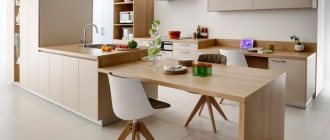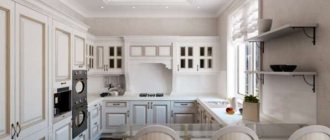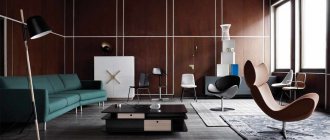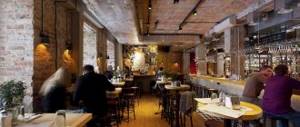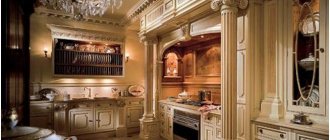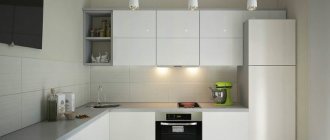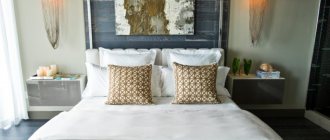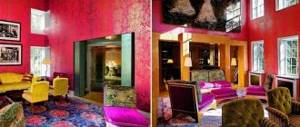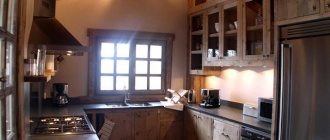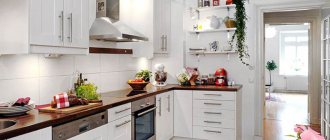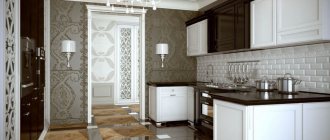Modern interior design has a tradition of moving away from stereotypes and classic solutions. They are being replaced by exotic interiors with great functionality.
Many modern designers are trying to pay attention to the Moroccan-style bathroom. Previously, this style solution was only a type of African interior, however, over time, it began to be distinguished as an independent direction.
- Features of African style in the interior of the bathroom
- Bathroom in Moroccan style and its features
- Moroccan style colors
- Decoration Materials
- Furniture in Moroccan style
- Accessories in Moroccan style
The bathroom has gained popularity because it contains ethnic elements that will not lose their relevance and will always be appropriate. It is thanks to these elements that many people choose the Moroccan style to create beauty in their bathroom. Africa has many countries and each of them has its own characteristics and its own culture. As for the Moroccan style, it stands out somewhat among all.
Features of African style in the interior of the bathroom
The concept of “African-style bathroom” includes individual elements from countries such as Tunisia, Egypt, Morocco, Algeria, Kenya, Nigeria and Chad. This also includes other states of the tropical continent. All these cultures have their own characteristics, but at the same time they are so similar to each other.
Moroccan-style bathroom design has also become popular because it perfectly combines African and Arabic cultures. Despite the fact that they are different and incompatible, two style lines are clearly visible here.
The African style direction, embodied in the interior of the bathroom, is manifested in the use of the following accessories:
- using bamboo branches as curtains;
- the use of clay souvenirs and figurines;
- ritual masks;
- handmade accessories created from tortoise shells and ivory;
- wooden utensils;
- lampshades for wicker type lamps;
- ferns;
- feathers of large birds.
If you use all these elements, you will be able to create a safari-themed bathtub. Its atmosphere will immerse you in the jungle and tropics.
The culture of Eastern countries can be traced through the use of arched motifs in the interior.
Bathroom in Moroccan style and its features
Many designers set themselves the goal of making the bathroom completely immersed in the atmosphere of the African desert, the world of the wild jungle and great possibilities. That's why they use additional Arabic-style elements that are reminiscent of tropical gardens and luxurious palaces.
Distinctive features of the Moroccan style can be represented by:
- hookahs;
- trays or jugs made of brass;
- ceramic vases decorated with paintings and other elements;
- bath accessories, which are stored in special boxes and chests;
- arches;
- original shaped mirrors.
In other words, we can say that the Moroccan style combines rustic simplicity and palace luxury.
Moroccan style colors
The African style palette has quite a lot of white, which is reminiscent of Asian motifs. Therefore, we can say that the main color of the style is white. And in order to diversify the bathroom and focus on African motifs, you should give preference to dark furniture.
A Moroccan-style bathroom can have the following color schemes:
- shades of orange;
- sandy shade;
- Red color;
- terracotta and brown color scheme;
- green palette.
When decorating a bathroom based on Egyptian motifs, colors such as scarlet, pink, blue, purple, burgundy and gold are used. As for the Moroccan interior, colors are not divided into ethnic areas. You can use all the above mentioned shades to create the most comfortable environment in your bathroom.
Characteristics of Moroccan design
The originality and originality of the oriental style can be a universal solution for decorating a dining room or living room.
However, if you have chosen a Moroccan-style kitchen design, you should know about its features and characteristic differences:
- Harmonious combination of warm and cold shades;
- Motley, but not flashy color;
- A large number of textile products;
- No sharp corners or sharp transitions;
- Drawings depicting the traditions of Morocco;
- Oriental ornaments or Arabic script;
- Use of natural raw materials for finishing;
- Forged elements in the interior.
Furniture and decorations for Moroccan cuisine
If you look at photos of Moroccan-style kitchens, the first thing that will attract your attention is the rich, custom furniture.
In order to fully embody the traditions of the ancient East in your kitchen, you will have to abandon the set that is familiar to us.
Your dining room should look more like the domain of an Arab sheikh than a cooking area. To ensure everything works out as it should, take note of a few tips:
- Organize not one, but several surfaces for working in the kitchen. You can decorate them with tiles or decorative patterns.
- A stylish and practical solution would be wall niches where you can store food or other necessary little things.
- Make several wooden shelves without doors where clay dishes and copper tall pots will be placed.
- Both furniture and decorative grilles can be used as forged elements;
- Instead of the usual massive table and chairs, use a miniature table, a couch and several soft poufs.
Note! Black kitchen - options for a stylish combination of glossy and matte black kitchen design (85 photos)
You can focus on a buffet decorated with precious stones, gilding or openwork fabrics.
If you still don’t want to part with your favorite kitchen set, then you can decorate it in the spirit of the mysterious and beautiful East.
Pay special attention to color scheme and some important details.
- Decorate the front of your cabinet in the style of decoupage or carquelure;
- Change the doors to lighter and openwork ones;
- Paint the glass with special paints or make a stained glass window;
- Install handles on the doors that imitate forged elements or precious metals;
- Tile at least one countertop;
- Decorate the kitchen and its attributes with wooden carvings.
Decoration Materials
When arranging the flooring in the bathroom, natural wood or stone is used, since these materials create coolness even on the hottest days of summer. Currently, tiles and simple laminate are popular. The only condition is that the materials must imitate nature.
The tropical style of the bathroom allows for the use of raw wood flooring. Different shades can be used here - from light yellow to dark brown tones.
In modern design, designers use ceramic tiles in light shades or porcelain stoneware.
The Moroccan style contains some Arabic elements, so very often when laying, additional modules are used as decorative inserts in contrasting colors. This allows you to recreate the original oriental pattern. The Egyptian-style bathroom has modules with Arabic designs.
Very often, walls are treated with decorative plaster with a textured application. It perfectly imitates the patterns of granite and marble. A bathroom created in the Arabic style can be decorated with simple plaster, however, it can also be painted in one of the shades of the palette that we listed above.
Nowadays, bathrooms with bright ceramic tiles on the walls are becoming more and more common. It is laid out in order to create an ethnic African ornament. If you decide to create an Egyptian style in the interior of your bath, it will be better if you choose a room with high ceilings. Proper design of the ceiling will create a feeling of height. Typically, such interiors use stretch fabric with a glossy surface.
Finishing the ceiling, walls and floor
In the Moroccan style, naturalness is encouraged, so the ceiling can simply be plastered and painted with waterproof paint in a neutral shade. If you have a sufficient budget for repairs, you can decorate the ceiling with stretch film with a pattern or carved wooden panels. The panels must be treated against rot and fungus; the presence of treatment is usually confirmed by a certificate.
In the Moroccan style, naturalness is encouraged, so the ceiling can simply be plastered and painted with waterproof paint in a neutral shade
The main focus is on the wall covering. In this capacity it is used:
- a rough layer of plaster coated with paint, imitating an adobe building;
- decorative plaster with a glossy effect creating the appearance of marble walls;
- large ceramic tiles with oriental patterns;
- small glossy mosaic up to 4x4 cm in size;
- ceramic cubes measuring 2x2 cm, which are traditionally called zelij;
- combined option.
To create a Moroccan style, tiles with traditionally oriental patterns are suitable, among them geometric patterns predominate (octahedrons, stars, rhombuses, squares). Such tiles are connected to each other according to mathematical rules, not chaotically. Tiles with a floral pattern look beautiful.
To create a Moroccan style, tiles with traditionally oriental patterns are suitable, among them geometric patterns predominate (octahedrons, stars, rhombuses, squares)
Moroccan tiles in the patchwork style look especially interesting. Selecting tile patterns on your own is quite difficult; it requires impeccable taste, so among the collections of ceramics you can choose ready-made versions of various patterns in a variety of colors.
By combining a plastered surface with ceramic inserts, you can get an interesting interior in which some areas (near the sink, shower) are highlighted with bright tiles.
Traditionally, in Morocco, floors are covered with stone tiles, which keep the room cool, but in domestic bathrooms it is necessary to first install a “warm floor” system
A frieze made of carved wood is installed at the junction between the ceiling and walls.
Important! Plastic products are inappropriate in a Moroccan-style bathroom.
Traditionally, in Morocco, floors are covered with stone tiles, which keep the room cool, but in domestic bathrooms it is necessary to first install a “warm floor” system. To save money, porcelain tiles, which have excellent decorative and functional qualities, are often laid on the floor.
Furniture in Moroccan style
A bathroom decorated in African style may have many niches in which figurines, vases or lamps are installed. If you follow the Moroccan style and adhere to all its ethnic trends, you should pay attention to windows and doors. It is better to use an arched design, as it is typical for all southern regions of the continent.
A tropical themed bathroom can be made using inexpensive woods as well as handcrafted items adorned with Arabic designs with precious stones. Stools and chairs have a soft base made of rough fabric in dark shades.
One of the mandatory conditions in interior design can be considered the presence of forged elements. You can use stands, shelves or furniture fittings.
Many designers, in the process of creating Moroccan style, use old products and remake them to meet new requirements. Furniture can be treated with stain to obtain the desired shade. Very often, countertops are decorated with mosaic tiles, which perfectly complement the design.
Choosing kitchen decor in the spirit of Morocco
A special place in creating a Moroccan kitchen interior is occupied by various niches and projections in the walls. The main thing here is to adhere to the golden mean in everything, so that the kitchen space does not look vulgar or overly pretentious.
Forged partitions can also be used as decoration. They will not only become a stylish element of decor, but will also serve as an excellent distinction between the working and dining areas of the kitchen.
To decorate the room you can use:
- Handmade clay dishes;
- Forged candlesticks, lamps, sconces;
- Wooden figurines, glass figurines;
- Colorful carpets and pillows;
- Jewelry made of silver and gold;
- Gilded mirrors;
- Pots with unusual plants.
Moroccan style in the kitchen interior is the embodiment of sophistication and an extraordinary approach to decorating your own home.
This trend combines exotic luxury and elegant simplicity.
The best options for kitchen corner sets for a small kitchen (100 photos)
How to choose the right floor tiles for the kitchen: types and selection tips
Kitchen design ideas in gray tones (100 photos)
A kitchen in which oriental motifs predominate will perfectly demonstrate the excellent taste of the owners and will become the main attraction of the house.
Note! Illumination of the work area in the kitchen - how to calculate it correctly? 90 photos of practical design!
Accessories in Moroccan style
It is worth making sure that the Moroccan-style bathroom has a sufficient number of textile elements. Expensive oriental-style fabrics with spectacular drapery will look appropriate and give the bathroom a noble appearance.
Taking into account all the features, we can say that the Moroccan style has become popular due to the fact that it combines all African and Arabic motifs. Every year, designers develop this style, creating new color combinations and making their imagination come true.
